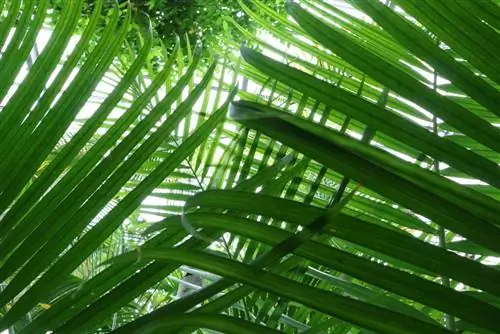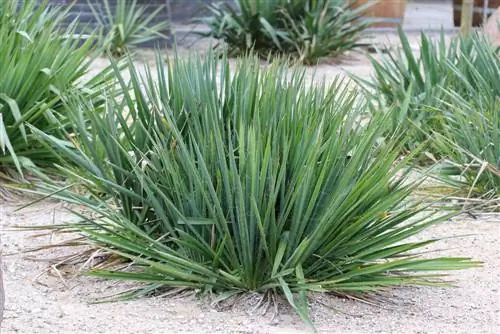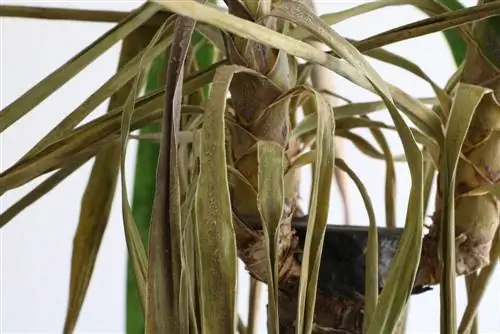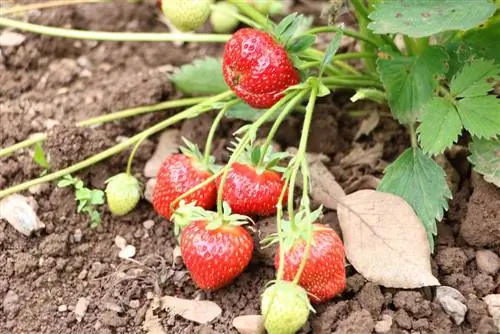- Author admin [email protected].
- Public 2023-12-17 03:39.
- Last modified 2025-01-24 12:45.
The betel nut palm Areca catechu, which is also called betel palm, areca palm or catechu palm, is not only an attractive houseplant, it also has a strong air-purifying effect. It has male and female flowers, forms fronds up to 2 m long and, in its native habitat, red drupes the size of a chicken egg, the so-called betel or areca nuts. The specimens cultivated here as houseplants generally do not produce any fruit and reach heights of around two meters.
Location and soil conditions
You can do a lot wrong with this plant when choosing a location. It requires a lot of heat both in the upper part of the plant and in the root area. Accordingly, if possible, it should not be placed on a cold window sill or a stone floor, at least not without an insulating coaster made of cork, for example. The room temperature should not fall below 20 °C during the day or at night; 20-25 °C would be ideal. This applies equally to summer and winter. The betel nut palm requires a bright to sunny location without blazing midday sun. Sun is favorable in the morning and evening hours and winter sun is tolerated. To protect it from intense sunlight, especially in summer, it is advisable to shade this plant. Otherwise burns can quickly occur.
Otherwise, it is important to place it in a humid environment with a humidity of over 60%. Accordingly, a place in a heated greenhouse is ideal, but it would also be in good hands in a winter garden. In normal living spaces, keeping them is difficult and usually doesn't last long. Commercially available standard mixtures are suitable as a substrate for indoor and potted plants, which can be made looser and more permeable by adding clay granules or sand. Special palm soil is also very suitable. Good drainage at the bottom of the planter is essential, ideally made of coarse gravel.
Tip:
A location should be chosen for the betel nut where it can grow and thrive in peace without being touched again and again. Even accidental brushing against the fine palm fronds can cause them to bend or even break.
Watering and fertilizing
- Watering should ensure that the substrate is always evenly moist.
- Ball dryness should be avoided, as should waterlogging.
- Due to sensitivity to cold, water only with lime-free and tempered water.
- Mist frequently and regularly to maintain high humidity.
- Use only lukewarm and naturally lime-free water.
- Do not fertilize in the first year after purchase or after repotting.
- Later from April to August/September, fertilize in low doses approximately every 3-4 weeks.
- Special palm fertilizers, liquid fertilizers or commercially available cactus fertilizers are suitable for this.
Tip:
When it is dry, the betel nut palm becomes sick very quickly and becomes more susceptible to pest infestation. Accordingly, care should always be taken to ensure there is sufficient moisture in both the soil and the air.
Repotting
This palm needs to be repotted occasionally, although it is enough to repot it about every 3 years, because it doesn't like being repotted too often. The best time for this is in spring. First, carefully lift the plant out of the pot, preferably at the lower part of the trunk, and shake off the loose soil. Then place them in the new planter in fresh substrate and water the whole thing well.
Growing this feather palm
The betel nut palm is grown exclusively from seeds, which is possible all year round. If you have been able to get hold of seeds of this rarity, you can first let them soak in lukewarm water for 1-2 days. Then place them about 1 cm deep in an appropriate growing substrate. Coconut fiber is particularly suitable for this because it is low in nutrients and well permeable. But pumice gravel or perlite, both germ-free, can also be used as a growing substrate.
No matter what kind of substrate is ultimately used, it should be kept evenly moist but not too wet throughout the entire germination period. For this it is advisable to cover the sowing container with a translucent film or glass. Or you can use a commercially available mini greenhouse. To prevent the substrate from becoming moldy or rotting, remove the foil or glass briefly every three days to ventilate the whole thing.
With a bit of luck, in a bright to partially shaded spot at temperatures between 25 and 30 °C, the first seedlings will appear after about 6-10 weeks. In the first 6 weeks after sprouting, the seedlings should not be exposed to direct sun. They can then be carefully separated around 8 weeks after germination. The fine roots of the young plants should be injured as little as possible to make it easier for them to grow.
Diseases and pests
Brown leaf edges and pointed or spotted leaves
Brown leaf edges and leaf tips are usually the result of dry room air or an unfavorable location. Accordingly, you should optimize the environmental conditions for this plant and spray it regularly with lime-free water. The brown tips and edges can be carefully cut off, but a thin strip of wilted material should always remain on the plant and should not be cut into the he althy tissue. Stains on the leaves often occur when the plant is sprayed with lime-containing tap water. This should be avoided at all costs and, if possible, only lime-free or at least particularly low-lime water should be used.
Tip:
To reduce the lime content of the water, you can, for example, mix two thirds of tap water with one third of distilled water. Or you can fill a small cotton or nylon bag with peat and hang it overnight in a container filled with tap water. The peat is supposed to remove limescale from the water
Scale and mealybugs
Mealybugs or mealybugs mainly occur when the air in the room is too dry. But unfavorable site conditions can also promote pest infestation, because then the plants are usually weakened and particularly vulnerable. Scale insects can be recognized by small brown plates on the leaves and on the leaf axils. On the other hand, a mealybug infestation appears in white cotton ball-like webs on the plant. After the plant in question has been isolated from others, most of the animals can be wiped with a damp cloth and then sprayed with a solution of soft soap and spirit, which must be repeated several times. The use of oil-containing preparations may cause the treated leaves to die. However, they can easily be applied to the trunk with a brush. The use of beneficial insects such as parasitic wasps, lacewing larvae or the Australian ladybird can be particularly helpful. In the case of a severe infestation, the use of suitable systemic agents is usually unavoidable.
Tip:
It is better to avoid scratching or scraping the scale insects, as there are often eggs under the scales of female animals. These could be distributed over the entire plant, so that a new infestation is programmed!
Conclusion of the editors
Keeping this extraordinary palm tree is not easy. The basic requirement for a he althy and magnificent plant is a bright location without blazing midday sun, warm soil and the highest possible air humidity. In normal living spaces the conditions are usually not optimal. A winter garden or heated greenhouse is better.
What you should know about the betel nut palm soon
- The betel nut palm ensures a he althy indoor climate and is also visually very beautiful.
- However, it needs a lot of warmth and humidity and is therefore not as easy to care for as other palm trees.
- In its homeland, such a feather palm grows up to 25 meters high and is particularly interesting because of its fruits.
Location
- The betel nut palm comes from tropical areas and therefore needs it to be nice and warm as a houseplant.
- A greenhouse is therefore well suited - it can also be placed in other rooms if the temperatures there are permanently around 20° C.
- It needs a lot of light, but should be protected from the midday sun.
- Especially on young plants, the leaves can easily burn in direct sunlight.
- If the temperatures are right, the betel nut palm can also be placed on the terrace throughout the summer.
- But it has to be brought back into the house in good time because it is not frost hardy.
Care
- The betel nut palm needs a lot of water. Because it loves high humidity, its leaves can be sprayed regularly.
- Only lime-free water at room temperature should be used for this.
- A betel nut palm is only fertilized sparingly and only during the summer months.
Betel nut
- In their homeland, betel nuts grow on such a palm tree. They are about the size of chicken eggs and are red in color.
- Inside the nut there is a brown seed surrounded by pulp.
- In Asia, unripe betel nuts are sold on the streets. They have a stimulating effect and curb the appetite.
- In larger quantities they are harmful to he alth or even fatal.
- The red color of betel nuts turns saliva red and is also used to color lips.
- With houseplants, however, it is extremely unlikely that betel nuts will form on the palm tree.
Problems in caring for betel nut palm
Brown tips or edges always form on the leaves when the humidity is too low. Then either the room climate should be improved or the palm tree should be sprayed more often. However, hard tap water must not be used because otherwise spots will quickly form on the leaves. The plant reacts to temperatures that are too low by barely growing. The main pests are scale insects and mealybugs. In both cases, the best treatment is to simply scrape the lice off the leaves.






